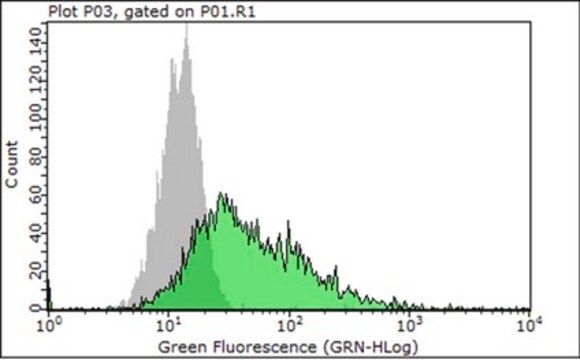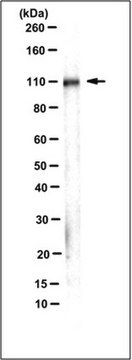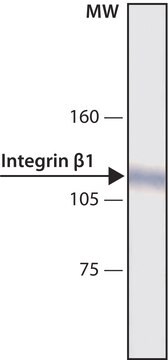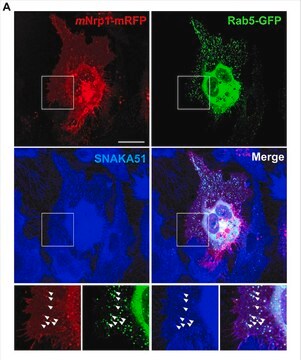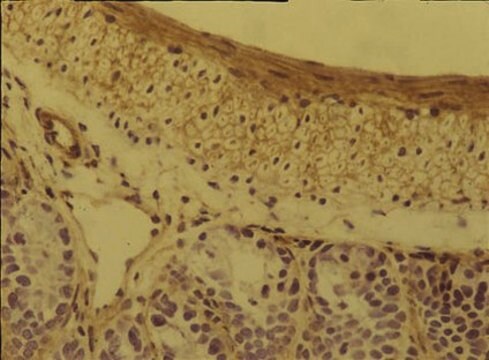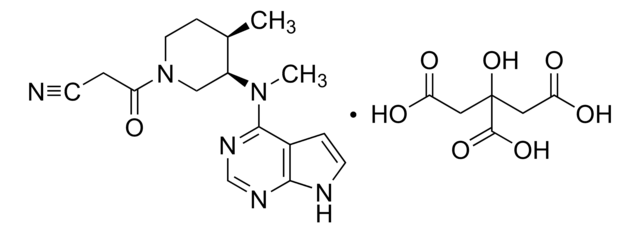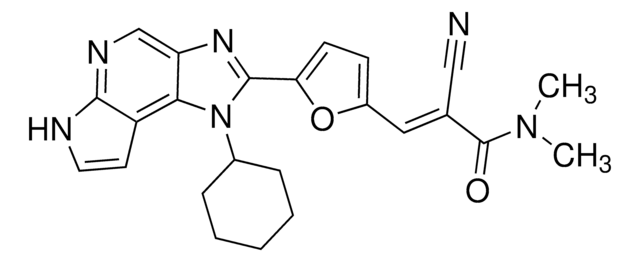MAB1956Z
Anti-Integrin α5 Antibody, clone P1D6, azide free
clone P1D6, Chemicon®, from mouse
Synonym(s):
CD49e, MAB1956
Sign Into View Organizational & Contract Pricing
All Photos(1)
About This Item
UNSPSC Code:
12352203
eCl@ss:
32160702
NACRES:
NA.41
Recommended Products
biological source
mouse
Quality Level
antibody form
purified antibody
antibody product type
primary antibodies
clone
P1D6, monoclonal
species reactivity
human
manufacturer/tradename
Chemicon®
technique(s)
immunohistochemistry: suitable
isotype
IgG3
NCBI accession no.
UniProt accession no.
shipped in
wet ice
target post-translational modification
unmodified
Gene Information
human ... ITGA5(3678)
General description
Integrin alpha 5 belongs to the integrin alpha chain family. Integrins are heterodimeric integral membrane proteins composed of an alpha chain and a beta chain. This gene encodes the integrin alpha 5 chain. Alpha chain 5 undergoes post translational cleavage in the extracellular domain to yield disulfide linked light and heavy chains that join with beta 1 to form a fibronectin receptor. In addition to adhesion, integrins are known to participate in cell surface mediated signalling.
Specificity
Reacts with Human alpha 5 integrin. Reactivity with other species is unknown.
Application
MAB1956Z is suitable for use in attachment inhibition assays using fibroblasts, endothelial cells, platelets and T & B lymphocytes on fibronectin.
MAB1956Z is not reactive with the denatured alpha 5 subunit. For immunoblotting, a dot blot is suggested as an alternative to western blotting.
MAB1956Z is not reactive with the denatured alpha 5 subunit. For immunoblotting, a dot blot is suggested as an alternative to western blotting.
Research Category
Cell Structure
Cell Structure
Research Sub Category
Integrins
Integrins
This Anti-Integrin α5 Antibody, clone P1D6, azide free is validated for use in IH, FUNC for the detection of Integrin α5.
Physical form
Format: Purified
Protein A purified
Purified mouse monoclonal in 0.01M Phosphate, 150mM NaCl, pH 7.4, containing no preservatives.
Storage and Stability
Maintain for 1 year at 2–8°C from date of shipment. Aliquot to avoid repeated freezing and thawing. For maximum recovery of product, centrifuge the original vial after thawing and prior to removing the cap.
Analysis Note
Control
Widely expressed, ovary
Widely expressed, ovary
Other Notes
Concentration: Please refer to the Certificate of Analysis for the lot-specific concentration.
Legal Information
CHEMICON is a registered trademark of Merck KGaA, Darmstadt, Germany
Disclaimer
Unless otherwise stated in our catalog or other company documentation accompanying the product(s), our products are intended for research use only and are not to be used for any other purpose, which includes but is not limited to, unauthorized commercial uses, in vitro diagnostic uses, ex vivo or in vivo therapeutic uses or any type of consumption or application to humans or animals.
Not finding the right product?
Try our Product Selector Tool.
Storage Class
12 - Non Combustible Liquids
wgk_germany
WGK 2
flash_point_f
Not applicable
flash_point_c
Not applicable
Certificates of Analysis (COA)
Search for Certificates of Analysis (COA) by entering the products Lot/Batch Number. Lot and Batch Numbers can be found on a product’s label following the words ‘Lot’ or ‘Batch’.
Already Own This Product?
Find documentation for the products that you have recently purchased in the Document Library.
Manish K Rana et al.
Journal of cell science, 128(6), 1083-1089 (2015-01-27)
Increased production and assembly of extracellular matrix proteins during transdifferentiation of epithelial cells to a mesenchymal phenotype contributes to diseases such as renal and pulmonary fibrosis. TGF-β and hypoxia, two cues that initiate injury-induced fibrosis, caused human kidney cells to
Juan Pablo Robles et al.
The Journal of biological chemistry, 298(3), 101695-101695 (2022-02-11)
Vascular endothelial cells (ECs) form a critical interface between blood and tissues that maintains whole-body homeostasis. In COVID-19, disruption of the EC barrier results in edema, vascular inflammation, and coagulation, hallmarks of this severe disease. However, the mechanisms by which
Meng Lu et al.
Hepatology (Baltimore, Md.), 68(1), 317-332 (2018-01-23)
Hepatocytes are epithelial cells with highly specialized polarity. The disorder and loss of hepatocyte polarity leads to a weakness of cell adhesion and connection, the induction of epithelial-mesenchymal transition, and eventually the occurrence of hepatocellular carcinoma (HCC). Cluster of differentiation
A J Miles et al.
The Journal of biological chemistry, 270(49), 29047-29050 (1995-12-08)
Tumor cell adhesion to the triple-helical domain of basement membrane (type IV) collagen occurs at several different regions. Cellular recognition of the sequence spanning alpha 1(IV)531-543 has been proposed to be independent of triple-helical conformation (Miles, A. J., Skubitz, A.
Elevated levels of the alpha 5 beta 1 fibronectin receptor suppress the transformed phenotype of Chinese hamster ovary cells.
Giancotti, F G and Ruoslahti, E
Cell, 60, 849-859 (1990)
Our team of scientists has experience in all areas of research including Life Science, Material Science, Chemical Synthesis, Chromatography, Analytical and many others.
Contact Technical Service